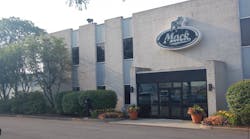Now, I’m such a truck junkie that touring assembly plants is something I really look forward to (though I am sure the way I duck in and out of the production line makes most folks fit to be tied).
But the real reason we’d been invited up to Mack’s home base for this two-day stretch centered in part on a renewed effort by the OEM to show why providing a “vertically integrated” product package can be a very good thing for the U.S. trucking community.
Now, there are plenty of naysayers out there when the talk turns to “vertical integration” and they’ve got plenty of valid reasons as to why the vertical integration philosophy that rules the European commercial vehicle market isn’t necessarily a good fit for the truckers on this side of the pond.
Yet David McKenna, director of powertrain sales and marketing for Mack, made a very good point about why “vertical integration” is being touted so strongly now in the U.S.
“Simply put, you cannot maximize the efficiency of the entire vehicle – the engine, the transmission, the axles, etc. – unless you share 100% of the information between them,” he explained.
“And let me tell you: no OEM is going to share the complete fuel map of their engine with a non-proprietary component maker. It simply won’t happen because you have no idea where that critical information might end up.”
That’s why he said Mack’s new “Super Econodyne” spec package for its Pinnacle line of Class 8 tractors delivers a significant boost to fuel economy without sacrificing power or performance: because the OEM controls every single aspect of the powertrain. “It simply would not work without a compete exchange of information between all the components,” McKenna noted.
Indeed, McKenna stressed that nothing is truly physically different between a regular Pinnacle Econodyne spec and the new “Super Econodyne” package. The 445 hp MP8 engine, 12-sp. mDrive transmission, and C125 rear axles have been in Mack’s product lineup for years.What’s different now, however, is the electronic controls governing those disparate components and how they are being “synched” together more efficiently than ever before by a new generation of software.
Indeed, McKenna noted that the OEM deliberately chose a shift “panel” instead of a floor- or steering column-mounted lever for the mDrive transmission within the “Super Econodyne” package so drivers wouldn’t be tempted to “fiddle around” with the gears.
“We want to let the engine and transmission do their job – to deliver exceptionally fuel economy with better power and performance, all at the same time,” he explained. “Any time you rev the engine over 1,400 rpms, all you are doing is making noise and wasting diesel. You have to change the way a truck is driven today to really maximize its efficiency all along the operating spectrum.”
Such a change to driving happens won’t come easy – even McKenna admits (jokingly, of course) that a it will involve “some clubbing” to get drivers to remove themselves from the gear-selection process.
But he believes – quite strongly – that it’s the only way to truly wring the most efficiency out of today’s modern truck, especially with all the emission regulations being piled on top of the industry.
“This is how we’re going to broaden the ‘sweet spot’ for fuel economy across a wider range of road speeds,” McKenna said.





